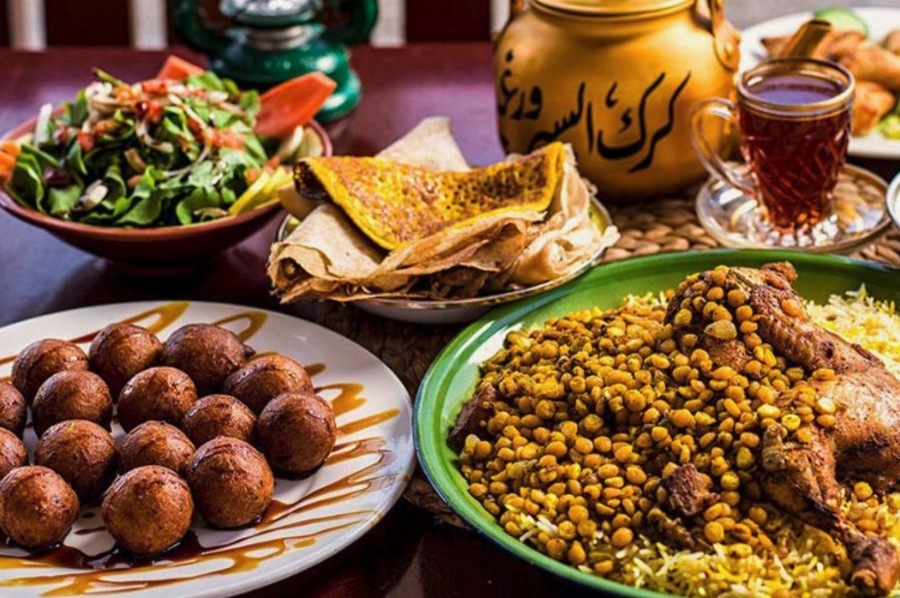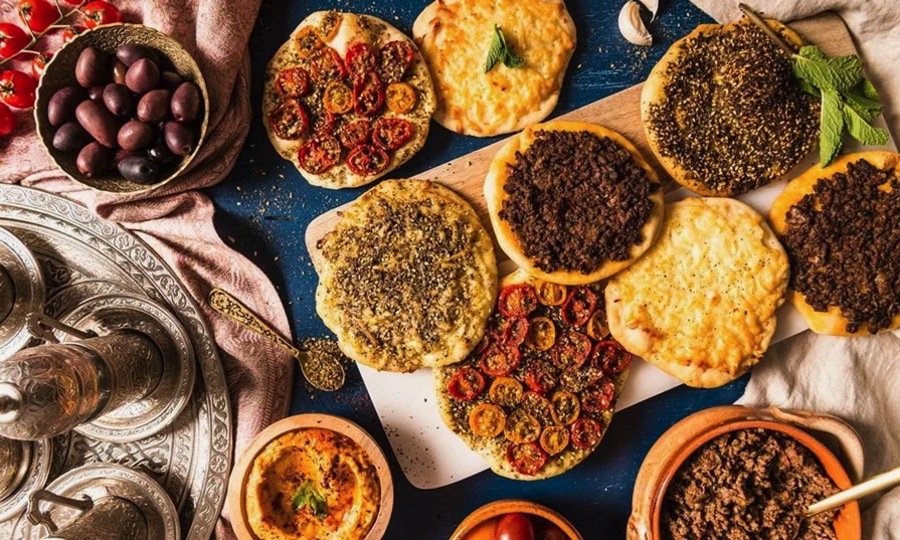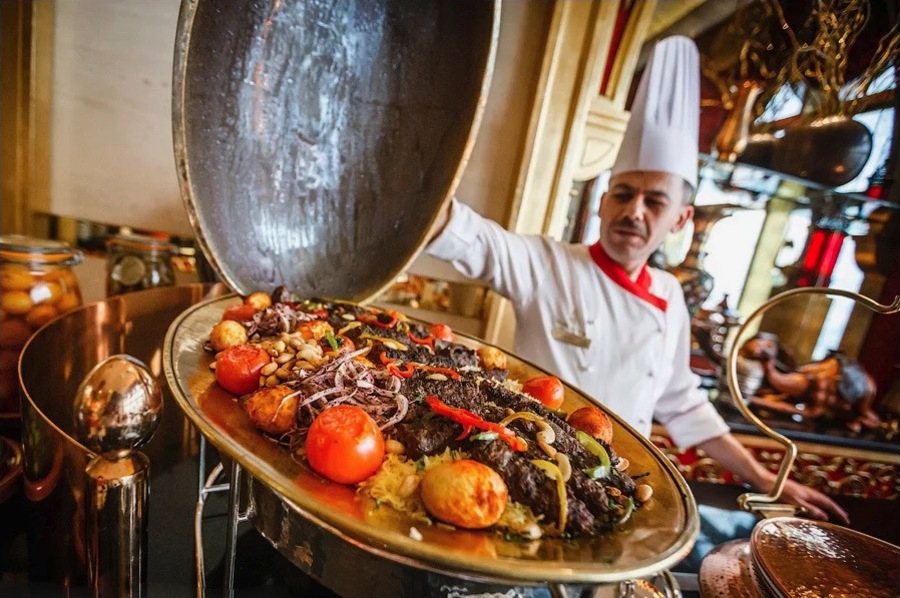Emirati cuisine, the traditional Arabic cuisine of the United Arab Emirates, is an integral part of East Arabian culinary traditions. It shares similarities with the cuisines of neighboring countries like Oman and Saudi Arabia and is influenced by various Middle Eastern and Asian cuisines. As a major international center, the UAE now represents a multicultural diversity of cuisines worldwide. However, its traditional cuisine remains a distinctive and cherished aspect of its cultural heritage. To experience the authentic flavors of Emirati cuisine at your next event, Rental Joy offers catering services that bring the rich culinary traditions of the UAE to your table.
Unique Characteristics of Emirati Cuisine
Emirati cuisine is known for its generous use of spices, the wrapping of meat and vegetables in thin tortillas, and the preparation of chickpea dishes. The cooking methods often reflect the Bedouin preference for one-pot meals, a practical approach in the water-scarce desert environment. Spices borrowed from India play a crucial role in flavoring, with a special local addition being dried lime, or lumi, which imparts a sour and slightly smoky flavor to meat and rice dishes. Sour sauces made with lemon, tamarind, and pomegranate juice further enhance the flavor profiles of meat dishes. The sweet offerings include familiar treats like halva, lukum, and baklava, alongside various other unique desserts.

Traditional Emirati Dishes
Here are some of the most iconic dishes of Emirati cuisine, each offering a unique taste of the UAE’s rich culinary heritage:
Masgouf
Masgouf is a traditional Emirati fish dish, often called the national dish of Iraq. It has been adopted into Emirati cuisine due to regional influences. It features fish, typically carp, marinated with olive oil, salt, turmeric, and tamarind before being grilled. The fish is usually butterflied and cooked over an open flame, imparting a smoky flavor. It is served with rice and a tangy tamarind sauce, making it a flavorful and satisfying dish.
Madruba
Madruba is a comforting and hearty dish made from chicken, spices, and rice. The ingredients are cooked until they reach a porridge-like consistency, creating a nourishing and flavorful dish. Traditionally, the dish includes spices such as cardamom, cinnamon, and saffron, which add depth and warmth. It is often served during the holy month of Ramadan, providing a filling meal that is easy to digest after a day of fasting.
Maqbous
Maqbous is a fragrant rice dish similar to biryani. It features spiced rice cooked with meat (usually chicken or lamb) and vegetables. The dish is flavored with a blend of spices, including saffron, cardamom, and cinnamon, and often includes dried lime for a unique tangy flavor. The meat is typically slow-cooked to ensure tenderness, and the rice absorbs the rich flavors of the spices and meat juices. Maqbous is often garnished with fried onions, nuts, and raisins, adding texture and sweetness.
Mansaf
Mansaf is a traditional dish commonly associated with Jordan but also popular in the UAE. It is made from lamb cooked in a sauce of fermented, dried yogurt called jameed and served over a bed of rice or bulgur. Mansaf is a communal dish, often served during large gatherings and special occasions. The lamb is typically seasoned with a blend of spices, and the jameed sauce adds a tangy and creamy element that complements the meat’s richness.
Balalit
Balalit is a sweet and savory dish made from vermicelli noodles cooked with sugar, cardamom, and saffron and topped with a thin omelet. Combining sweet noodles and savory eggs creates a delightful contrast of flavors. Balalit is often enjoyed as a breakfast dish, providing a unique and flavorful start to the day.
Chicken Fuga
Chicken Fuga is a traditional Emirati dish featuring chicken marinated with a mixture of spices, including turmeric, cumin, and coriander, then slow-cooked until tender. The chicken is often served with rice or bread and accompanied by vegetables. The slow-cooking process ensures that the chicken is infused with the rich flavors of the spices, resulting in an aromatic and satisfying dish.
Hamir
Hamir is a traditional Emirati bread, typically made from wheat and barley flour. It is baked until golden brown and has a slightly chewy texture. Hamir is often enjoyed with various dips and spreads, such as hummus or date syrup, and is a staple in Emirati households.
Chebab
Chebab is an Emirati pancake, similar to a crepe, but thicker and often flavored with cardamom and saffron. The pancakes are typically served with date syrup or honey, making them a popular choice for breakfast or dessert. Adding spices gives Chebab a distinctive flavor, setting it apart from other pancakes.
Lukamat
Lukamat are sweet dumplings made from flour, yeast, and sugar in a dough. They are deep-fried until golden brown and drizzled with date syrup or honey. These bite-sized treats are crispy on the outside and soft on the inside, making them a beloved dessert during Ramadan and other festive occasions.
Habisa
Habisa is a traditional Emirati dessert made from wheat, molasses, and spices such as cardamom and saffron. The ingredients are cooked together to form a thick, pudding-like consistency. Habisa is often enjoyed during the winter months, providing a warm and comforting end to a meal.

The Evolution of Emirati Cuisine
While the UAE cuisine shares similarities with neighboring countries, it has its unique taste and is a must-try for anyone visiting the region. Emirati cuisine has evolved over the years, incorporating influences from various cultures and adapting to modern tastes while preserving its traditional roots.
In the past, the locals’ diet was modest and not too diverse. On weekdays, meals typically consisted of rice, flatbread, camel milk, and dates, with stewed lamb or goat meat reserved for special occasions. Coastal communities supplemented their diet with fish. As the UAE developed into a wealthy nation, the variety and richness of its cuisine expanded, integrating flavors and techniques from Indian, Persian, and Levantine cuisines, among others.
Experiencing Emirati Cuisine
Whether planning a wedding, birthday, or a party with national treats, Rental Joy in the UAE can help you organize a memorable event with traditional Emirati dishes. For example, a buffet for ten people will cost you only 1485 dirhams, ensuring an authentic and delicious experience for your guests.
Emirati cuisine offers a rich and diverse array of flavors, reflecting the country’s cultural heritage and culinary traditions. From savory meat dishes to sweet desserts, the cuisine of the UAE provides a unique and unforgettable taste of the Middle East.
Conclusion
Emirati cuisine reflects the UAE’s rich cultural heritage and openness to global influences. Each dish tells a story of tradition, adaptation, and innovation. Whether enjoying a simple meal of dates and flatbread or indulging in a luxurious feast, the flavors of Emirati cuisine offer a unique and memorable culinary experience. Exploring the traditional dishes of the UAE is not just about tasting the food; it’s about experiencing a part of the culture and history that makes this nation so special.

Skydiver, vegan, hiphop head, International Swiss style practitioner and AIGA member. Performing at the fulcrum of design and function to save the world from bad design. I am 20 years old.


